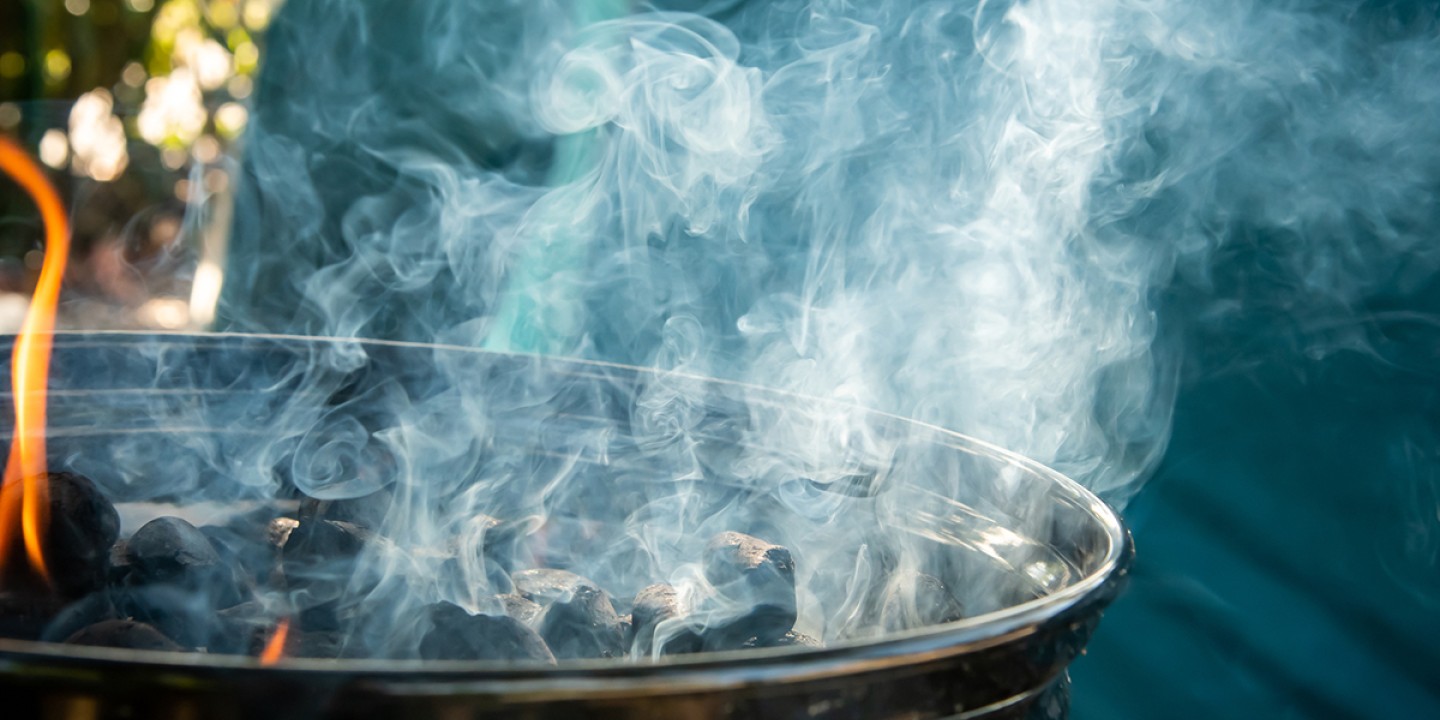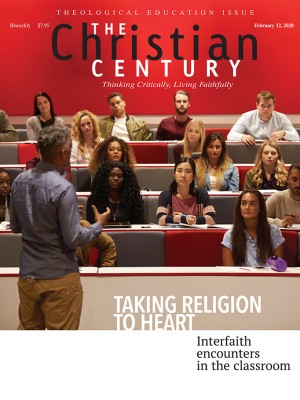
Around the beginning of May, signs start going up around my neighborhood advertising the Hava NaGrilla Smoke BBQ Festival, the country’s largest charity kosher barbecue festival. Held at the local synagogue, Temple Beth Hillel-Beth El, the festival gathers a few hundred people from across the region. The signs are unavoidable, and they advertise the festival with the word Smoke in large font. Truthfully, that’s all I need: smoke.
I am attracted to smoke. Especially smoke that has wrapped itself around a piece of meat. Add that smoke to a clever pun on a Hebrew folk song, throw in an opportunity to do some interfaith community building, multiply that by the fact that I have never been to a kosher barbecue festival, and compound it with the news that it was going to have a mechanical bull—I knew that my Sunday afternoon in June was booked.
Read our latest issue or browse back issues.
In a very literal way, a love of smoke is imprinted into our DNA. In his book Catching Fire, primatologist Richard Wrangham argues that the human evolutionary jump to becoming big-brained mammals with small intestinal tracts is due to our unique ability among the animal kingdom to harness fire for cooking. The ability to apply fire to food has allowed us to easily consume more calorically dense food, thus feeding energy to our brains. Cooked food is softer and easier to digest than raw food, so rather than having to spend the better part of our days chewing, we can eat three squares in a few minutes. Our evolution, according to Wrangham, smells like smoke.
On the morning of the Hava NaGrilla barbecue festival, I smell the festival before I see it. Long before anyone has arrived at the synagogue, the barbecue teams have been smoking brisket for nearly ten hours. Holding a kosher barbecue competition requires an impressive attention to detail.
The previous night, the synagogue gave brand new smokers to each team. A rabbi inspected all the utensils and made sure that the group used the supplied kosher meat. The kosher standards of the competition are vital for the event. Gathering the wide religious expressions in the neighborhood means adhering to the strictest possible standards.
Regardless of how kosher the operation is, the smoke smells the same: sweet, with notes of vanilla and bitter charcoal. As I drive by the synagogue in the early morning on my way to church, I feel compelled to pull the car to the side of the road. The morning is quiet and I am in no hurry, so I tarry in the smoke. Later in church, people will remark that I smell like smoke. I don’t know if they mean it as a compliment, but I take it as one.
Hava NaGrilla is the brainchild of orthopedic surgeon Stuart Gordon. Gordon told me that he was sitting at a lecture at the Hillel organization at the University of Pennsylvania reflecting on the divisions in the Jewish community. He realized that it was hard to gather the various strains of Judaism in the same place.
“We are one big Jewish family,” he told me, “but we never gather under a single umbrella.” Gordon has the infectious enthusiasm required to put on an event this big with a goal as noble as unity. Inspiration for the gathering came from the conviction that “everyone loves barbecue and everyone loves beer.” Barbecue and beer, according to Gordon could “take the weirdness out of the stranger.” Thus Hava NaGrilla was born. From the ultra-Orthodox yeshiva at the edge of the Philadelphia to the Reform temple a mile away, Gordon sought to entice everyone with smoke.
Historians suggest that in first-century Jerusalem, more than 250,000 sheep were sacrificed over the course of Passover week. These sheep were “roasted with fire” as Exodus commands. For Passover week, Jerusalem smelled like smoke. It clung tightly to the priests responsible for the sacrifices and rested on the pilgrims as they returned home from the sacrifice. When Jesus entered Jerusalem to celebrate the Passover, the city would have smelled like a barbecue festival. That smoke smelled like hope. The Passover lamb, the sign of liberation from imperial oppressors, permeated the city, and no imperial army could make it disappear. Smoke smelled like restored community, like peace, like freedom.
But as always happens, the signs of hope twist easily into signs of despair. Years later, after Jesus was executed and Roman power shifted hands, Titus, son of Emperor Vespasian, laid siege to Jerusalem. The great Jewish historian and former rebel commander Josephus catalogued the terrors that Titus inflicted upon the great city and the terrors the rebels within the walls inflicted upon themselves.
In one particularly troubling passage, Josephus recounts the story of a starving gang who savagely turned over the city to find any food. One day the gang smelled the unmistakable scent of cooked meat. Following their noses, the gang broke into the home of a wealthy woman to find her son being cooked over fire. Disgusted by the barbarity, they returned to their hunger. Weeks later, as Josephus describes in vivid detail, the temple burned to the ground. A pyre of stone, metal, and humanity was turned to an indiscriminate pile of ash. All smell of hope was replaced by a putrid stench of despair.
At its heart, smoke is a sign of failed destruction. Fire consumes. Fire requires fuel, and at the right temperature most anything can be fuel. Smoke is a sign of incomplete combustion—the failure of fire to fully consume what it is burning. When directed specifically and skillfully, that failure is sweet. It means a perfectly cooked brisket and the bitter char on grilled vegetables. It smells like the hearth—a place where fire, smoke, and food combine to represent the heart of home. Directed thoughtlessly or with murderous intent, the failure of fire smells tragic. It smells like death.
Sometimes you cannot tell the difference between the sweet smoke of home and stench of tragedy. I grew up in Southern California, the land of wildfires. Most forest fires there are preceded by a shift in the wind. The typical moist ocean breeze that cools the coast changes direction, and winds develop that grow dry and sharp as they pass over the Mojave Desert. The sagebrush becomes tinder, and a small spark becomes a consuming fire.
Recently, after living on the East Coast for years, I flew into California, exited the plane, and smelled ash and soot in the air. The San Bernardino Mountains were on fire. I had friends and family whose homes were in danger. Even as I knew the destructive power of the burning fire, I was deeply comforted by that smell. It smelled like home. I can’t totally explain what it feels like to smell destruction and feel at home.
Perhaps this is what the Israelites felt like as they walked downwind of their pillar of fire. The fire was home. When it stopped, the nation stopped. When it moved, the nation moved. Did the pillar leave a trail of ash in its wake? A dark path of smoke and char stretching from the Red Sea to the promised land? I suspect that the generation that knew the pillar of fire and then settled in the land of promise and burned the chaff of their wheat remembered that pillar. I bet it smelled like home.
When I arrive at the Hava NaGrilla barbecue festival with my friend Greg and my son Elliot, the festival is already densely packed with people. Lines stretch around the large smokers, and the lines at the beer and whiskey tent are just as long. In some ways, the protocols of a barbecue festival are the same at Temple Beth Hillel-Beth El as they are at festivals in Memphis, or Kansas City, or Austin: get in line, buy some food (no pulled pork here), get a beer, and find a communal table where you can eat and chat with your neighbors.
But this festival comes with some minor new protocols to learn. Does the kippah stay on or come off when you are about to ride a mechanical bull? Do you shake hands with the other genders or nod politely? As with most situations in life, the kids on the playground learn to negotiate the protocols quicker than the adults.
Around the periphery of the parking lot are tired members of the barbecue teams. Some of them participate in the competitive barbecue circuit, some are strictly kosher teams, some have never entered a competition before, let alone a kosher one. For more than twelve hours the teams coaxed smoke from wood and fire. Cooking barbecue takes equal parts attention and relaxation. Watch too much and your temperature fluctuates. As the saying goes, “If you are looking, you ain’t cooking.” But if you don’t watch at all, the brisket can dry up or the fire can go out. You need to pay attention to your inattention.
This is the lesson of barbecue for me as I wait in line: community, like barbecue, can’t be forced. It takes patience, attention, and risk. Creating something beautiful, be it barbecue or fellowship, requires submitting something precious to a dangerous fire and the accompanying smoke. Risk of destruction is part of the equation. Sometimes it works—delicious brisket, delicious community. Sometimes it all comes out dry as a brick. But without the fire, we don’t eat.
After handing in their prized portions, the barbecue teams collapse on the grass and start sharing their food. One team brings out their special spice blend, Bubbies, and offers a taste to the other teams. Greg gets the beer and food while Elliot rides the mechanical bull. Finally we all sit down under a tree to eat.
Gordon told me that when the people gathered at the base of Mount Sinai, as Moses climbed the mountain, it was the first and perhaps only time that the nation was truly one. But here, in a parking lot in the Philadelphia suburbs, you can hear the echo of that oneness.
At the bottom of the mountain, finally free from bondage, the Israelites ate together without fear. They gathered around the fire and told stories, shared food, and let their kids wander freely around the camp. In a real sense, they were getting to know each other again. They were taking the weirdness out of their new identity as a free people. Here in the parking lot, Jews, Christians, Muslims, atheists, agnostics—and even some vegetarians—were sitting and eating under a cloud of smoke.
A version of this article appears in the print edition under the title “The smoky smell of hope.”





